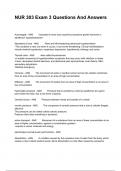NUR 303 Exam 3 Questions And Answers
Acromegaly - ANS Increased in bone size caused by excessive growth hormone in
adulthood- hyperpituitaryism
Myxedema Coma - ANS -Rare and life-threatening advanced hypothyroidism
-This condition is rare, but when it occurs, it can be life threatening. Clinical manifestations
include marked hypotension, respiratory depression, hypothermia, lethargy, and coma.
Thyroid crisis - ANS -Also called thyrotoxicosis
-A sudden worsening of hyperthyroidism symptoms that may occur with infection or stress
-Fever, decreased mental alertness, and abdominal pain dysrhythmias, heart failure, N&V,
secondary dehydration
-Medical emergency
Osmosis - ANS The movement of water or another solvent across the cellular membrane
from an area of low concentration to an area of high concentration
Diffusion - ANS The movement of solutes from an area of high concentration to an area of
low concentration
Hydrostatic pressure - ANS Pressure that is exerted by a fluid at equilibrium at a given
point within the fluid, due to the force of gravity
Osmotic forces - ANS Pressure between inside and outside of a vessel
oncotic pressure - ANS The component of osmotic pressure that is due to colloids (largely
albumin)
This pressure can be called colloid osmotic pressure.
Pressure that holds something in (proteins)
active transport - ANS Movement of a substance from an area of lower concentration to an
area of higher concentration, against a concentration gradient
-requires a carrier molecule and energy
electrolytes (normal levels and function) - ANS
dehydration - ANS A condition caused by the excessive loss of water from the body, which
causes a rise in blood sodium levels. Since dehydration is most often caused by excessive
,sweating, vomiting, or diarrhea, water loss is usually accompanied by a deficiency of
electrolytes.
target cell receptors (definition and their location) - ANS A given hormone usually affects
only a limited number of cells, which are called target cells. A target cell responds to a hormone
because it bears receptors for the hormone.****
Hormones secreted in the adrenal medulla - ANS In times of stress secretes: (mediates
fight or flight)
Epinephrine
Norepinephrine
Hormones secreted in the adrenal cortex - ANS Mineralocorticoids- secretes aldosterone
(acts to conserve sodium and water)
Glucocorticoids- secretes cortisol (increases serum glucose levels)
Gonadocorticoids- sex hormones: androgen (Male) estrogen (female)
Secretions of the anterior pituitary - ANS 1) Growth hormone: Stimulates cell growth and
fat breakdown- primarily targets are the muscle and bone, where GH stimulates amino acid
uptake and protein synthesis
2) Thyroid-stimulating hormone (TSH): Stimulates reslease of thyroxine and triiodothyronine
3) Adrenocorticotropic hormone (ACTH): Stimulates secretion of hormones by the adrenal
cortex, especially glucocorticoids
4) Gonadotropins (FSH, LH): Stimulate gamete production and hormone production by the
gonads
5) Prolactin: Stimulates milk production by the breast
6) Melanocyte-stimulating hormone (MSH): Function in humans is unknown
Secretions of the posterior pituitary - ANS 1) Antidiuretic hormone (ADH): stimulates water
reabsorption by nephrons of the kidney
2) Oxytocin: stimulates breast to release milk and uterine contractions during birth
Secretions of the hypothalamus - ANS Contains several types of neurons responsible for
secreting hormones:
1)Thyrotropin-releasing hormone (TRH): stimulates anterior putuitary to release TSH
, 2) Gonadotropin-releasing hormone (GnRH): Stimulates anterior pituitary to release FSH+ LH-
normal function of testes& ovaries
3) Growth hormone-releasing hormone (GHRH): Stimulates anterior pituitary to release GH
4) Corticotropin-releasing hormone (CRH): Stimulates secretions and release of ACTH
5) Somatostatin.
6) Dopamine.
7) Oxytocin- orgasm, the ability to trust, body temp, sleep cycle, the release of breast milk
8) Prolactin-releasing hormone (PRH)- or proactin-inhibiting
Know fight of flight hormones- where they are secreted*****
What does the thyroid do? Causes and manifestations of hyper/hypo? - ANS Thyroid:
contains follicles that produce hormones:
1) Thyroxine (T4)
2) triiodothyronine (T3)
3) Thyrocalcitonin or calcitonin
Help regulate cellular metabolism as well as growth and development
Calcitonin: regulates serum levels by inhibiting osteoclast activity
MANIFESTATIONS:
Hyperthyroidism: results from increased TSH levels- headache, visual field loss or double vision,
excessive sweating, hoarsness, galactorrhea, sleep apnea, carpal tunnel syndrome, joint pain
and stiffness, muscle weakness, paresthesia
Hypothyroidism: Does not produce sufficient amounts of the thyroid hormones- manifestations
develop slowly over years usually-
fatigue, sluggishness, increased sensitivity to cold, constipation, pale dry skin, edema in face,
hands, and feet, hoarseness, hypercholesterolemia, unexplained weight gain, myalgia,
arthralgia, muscle weakness, heavier than normal menstraul periods infertility, brittle fingernails,
hair loss or thinning, bradycardia, hypotension, depression, goiter
What does the parathyroid do? Causes and manifestations of hyper/hypo? - ANS
Parathyroid: secretes parathyroid hormone (PTH) to regulate serum calcium levels
MANIFESTATIONS:




